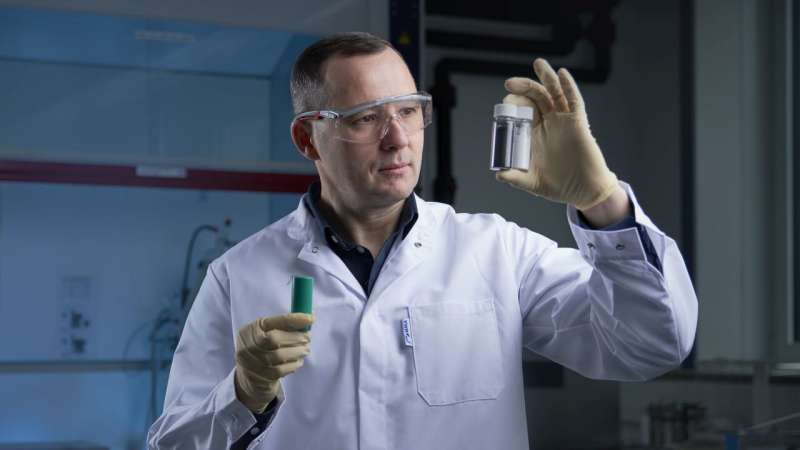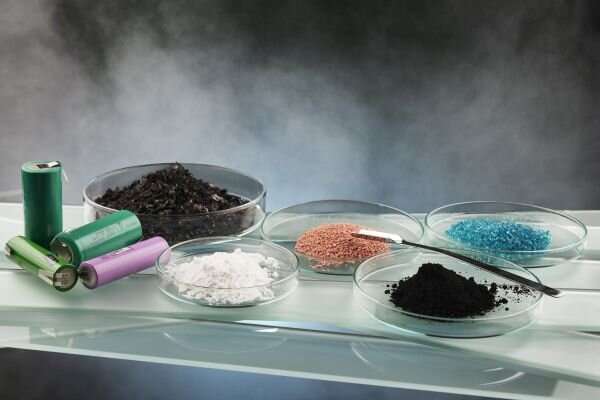
A recycling method developed by Karlsruhe Institute of Technology (KIT) recovers up to 70% of lithium from battery waste without corrosive chemicals, high temperatures, and prior sorting of materials being required. The method combines mechanical processes with chemical reactions and enables inexpensive, energy-efficient, and environmentally compatible recycling of any type of lithium-ion battery. The results are reported in Communications Chemistry.
Lithium-ion batteries are omnipresent in our life. They are not only used for the wireless power supply of notebooks, smartphones, toys, remote controls, and other small devices, but also are the most important energy storage systems for the rapidly growing electric mobility sector. Increasing use of these batteries eventually results in the need for economically and ecologically sustainable recycling methods.
Presently, mainly nickel and cobalt, copper and aluminum, as well as steel are recovered from battery waste for reuse. Lithium recovery still is expensive and hardly profitable. Existing recovery methods mostly are of metallurgical character and consume a lot of energy and/or produce hazardous by-products. In contrast to this, mechanochemical approaches based on mechanical processes to induce chemical reactions promise to reach a higher yield and sustainability with a smaller expenditure.
Suited for various cathode materials
Such a method has now been developed by the Energy Storage Systems Department of KIT’s Institute for Applied Materials (IAM-ESS), the Helmholtz Institute Ulm for Electrochemical Energy Storage (HIU) established by KIT in cooperation with Ulm University, and EnBW Energie Baden-Württemberg AG.
The method reaches a lithium recovery rate of up to 70% without corrosive chemicals, high temperatures, and prior sorting of materials being required. “The method can be applied for recovering lithium from cathode materials of various chemical compositions and, hence, for a large range of commercially available lithium-ion batteries,” says Dr. Oleksandr Dolotko of IAM-ESS and HIU, the first author of the publication. “It enables inexpensive, energy-efficient, and environmentally compatible recycling.”

Reaction at room temperature
The researchers use aluminum as reducing agent in the mechanochemical reaction. As aluminum is already contained in the cathode, no additional substances are required. The method works as follows: First, the battery waste is ground. Then, this material reacts with aluminum to metallic composites with water-soluble lithium compounds.
Lithium is recovered by dissolving these compounds in water and subsequent heating to make the water evaporate. As the mechanochemical reaction takes place at ambient temperature and pressure, the method is highly energy-efficient.
Another advantage is its simplicity, which will facilitate use on an industrial scale, as large amounts of batteries will have to be recycled in the near future already.
More information:
Oleksandr Dolotko et al, Universal and efficient extraction of lithium for lithium-ion battery recycling using mechanochemistry, Communications Chemistry (2023). DOI: 10.1038/s42004-023-00844-2
Citation:
Inexpensive and environmentally friendly mechanochemical recycling process recovers 70% of lithium from batteries (2023, March 30)
retrieved 30 March 2023
from https://techxplore.com/news/2023-03-inexpensive-environmentally-friendly-mechanochemical-recycling.html
This document is subject to copyright. Apart from any fair dealing for the purpose of private study or research, no
part may be reproduced without the written permission. The content is provided for information purposes only.
Stay connected with us on social media platform for instant update click here to join our Twitter, & Facebook
We are now on Telegram. Click here to join our channel (@TechiUpdate) and stay updated with the latest Technology headlines.
For all the latest Technology News Click Here
For the latest news and updates, follow us on Google News.
